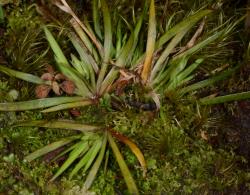- Taxon
- Gallery
Plants consisting of leafy fans erect or semi-erect; sparsely branched leafy rhizomes, (30–)50–100(–180) mm long, attached to substratum, sometimes insecurely, by thin, wiry roots. Leaves 30–100(–220) mm × 1–3.5(–5) mm, the downward-facing surface much duller than the upper, due to more white lines of stomata and raised cells being present; veins inconspicuous, leaf bases green or pale yellow, leaf margins often finely scabrid, stomata often only present on lower surface of leaf; leaf in transverse section simple, only one row of vascular bundles present, marginal vascular bundle absent, no sclerenchyma on inside of leaf sheath. Inflorescences long, usually greater than leaves; peduncle slender. Panicle simple; bracts 5–35 mm long, narrow lanceolate, green or brown when dried, in clusters of three or more; 1–8 flowers on very slender, usually pubescent pedicels, 13– 35 mm long. Flowers white, 5–12(–15) mm diam., predominantly tepallate, outer whorl slightly shorter and narrower, elliptical with apiculus, inner whorl larger, elliptical with apical cleft. Staminal filaments very shortly connate; anthers c. 1.5 mm long; pollen sacs white, narrow, connective broad; pollen ellipsoidal, monosulcate, 28.5–41.8 × 19.0–34.2 µm. Ovary triquetrous, c. ¼ length of the perianth bud at anthesis; style branches not winged, pointing upwards. Capsule triquetrous, 2–3 × 2–5 mm; dehiscing by loculicidal splitting; valves keeled and strongly recurved at dehiscence, green-brown. Seeds 0.75–1 × 1–1.2 mm, rounded to egg-shaped, almost smooth, yellow. FL Sep–Dec; FR Dec–Jun.
[Reproduced from Blanchon et al. (2002, New Zealand J. Bot. 40: 437–456) with permission from The Royal Society of New Zealand.]




